Understanding Love Bugs: Seasonal Impact & Tips
Explore the world of love bugs: Understand their seasonal appearances and get essential tips to minimize their impact on your life.
HELPFUL INFORMATION
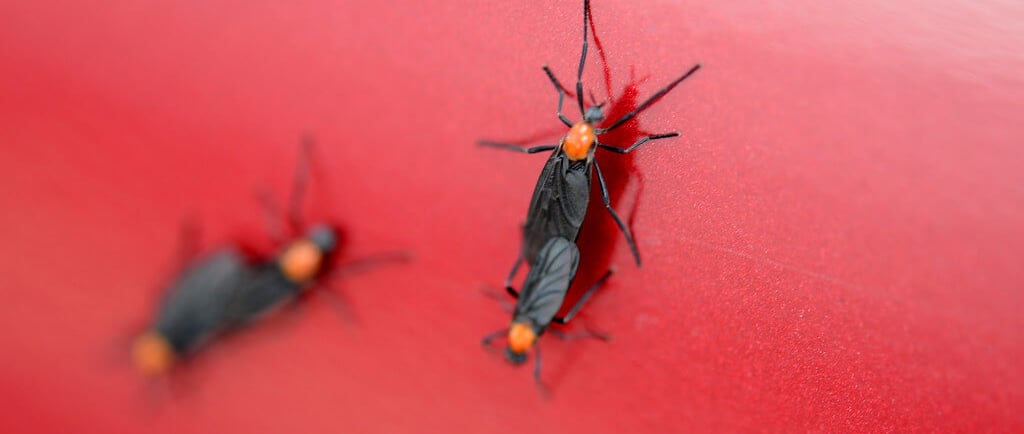

A Guide To Help Ease The Pain Of Love bug Season...
Welcome to our comprehensive guide on love bugs. In this article, we will delve into the intriguing world of these insects, exploring their seasonal impact and providing valuable tips to manage their presence. Whether you're dealing with love bugs invading your backyard or finding ways to protect your car from their splatters, we've got you covered.
Love bugs, scientifically known as Plecia nearctica, are small black insects with a special characteristic: they fly together in pairs connected at the abdomen. These harmless bugs have a reputation for invading areas during certain times of the year, causing inconvenience for homeowners, drivers, and people who enjoy being outdoors.
In this article, we will examine the history and life cycle of love bugs. We will also explore what attracts them and their seasonal patterns in Florida. Additionally, we will provide practical strategies to eliminate love bugs and offer tips to reduce encounters with them. So, whether you're curious about the origins of love bugs, interested in understanding their behavior, or looking for effective ways to get rid of them, stay tuned. Let's explore the world of love bugs and learn how to coexist with these unique insects.

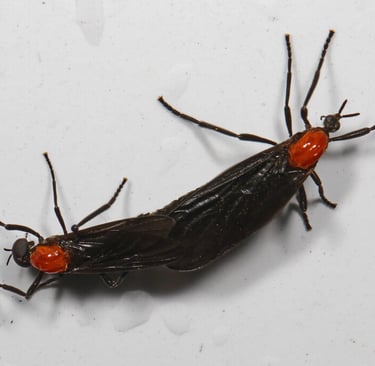
History of Love Bugs
Love bugs, scientifically known as Plecia nearctica, are an interesting type of insect that have made a name for themselves in the southeastern United States, especially in Florida. Learning about the history of love bugs can give us valuable information about their behavior and when they are most active.
Love bugs originally came from Central America and started appearing in Florida in the 1940s. It is believed that they were brought to the region by strong winds during migration.
Since then, love bugs have become very common and can be seen during specific times of the year when they are active.
These bugs are famous for their mating behavior, where they can be seen flying together in a unique "love" position. This is how they got their memorable name. Love bugs fly close to the ground and their movement can appear erratic to humans.
Love bugs have a short lifespan, living for only a few weeks. They are most abundant and active in May and September, when their population reaches its peak. This increase in their numbers can have a big impact on the environment and can be challenging for people living in affected areas.
The Arrival of Love Bugs in Florida
The arrival of love bugs in Florida caught the attention of researchers and bug experts. Their quick adaptation to the local environment and subsequent population growth raised questions about how they affect ecosystems and agriculture.
Despite being found everywhere and sometimes causing annoyance, love bugs do play a role in the environment. As adults, they mainly feed on nectar from flowers, helping with pollination. However, their presence can also cause problems, like clogging car radiators and damaging paint on vehicles. Over the years, many studies have been done to better understand love bugs and their behavior. Researchers are still keeping an eye on their migration patterns, when they are most active, and ways to control their population to minimize the disruptions they cause.
The life cycle of love bugs:
Understanding the life cycle of love bugs is essential to gaining insight into their behavior and developing effective management strategies. From egg-laying to adulthood, love bugs go through several stages of development. Let's explore their fascinating life cycle:
Egg-Laying: Female love bugs lay their eggs on plants, trees, and other vegetation. These eggs are small and oval-shaped and are usually found in groups, providing a good environment for the next generation.
Larval Development: Once the eggs hatch, the young love bugs, called larvae, come out and start feeding on decaying organic matter. They have an important role in recycling nutrients, which helps keep the ecosystem balanced.
Pupation: During the pupal stage, the larvae go through a transformation inside protective cocoons. This stage allows them to go through important physical changes that prepare them for adulthood.
Adulthood: After the pupal stage, the adult love bugs come out of their cocoons. They have black bodies and bright red thoraxes, which make them easy to recognize. Adult love bugs usually have a short lifespan, lasting only a few weeks.
Understanding the life cycle of love bugs gives us valuable information about their behavior and biology. By learning about their different stages of development, we can better understand their role in the ecosystem and find effective ways to manage their presence.
What Attracts Love Bugs?
Love bugs are intriguing little creatures that possess a mesmerizing yet somewhat annoying presence. Understanding what attracts these insects can help us better manage their population and reduce their impact. Let's explore a few factors that make certain environments and situations more appealing to love bugs.
One of the main factors that attract love bugs is the environmental conditions. These insects thrive in warm and humid climates, which explains their prevalence in certain regions, such as Florida. The combination of temperature and moisture creates an ideal habitat for love bugs to breed and multiply.
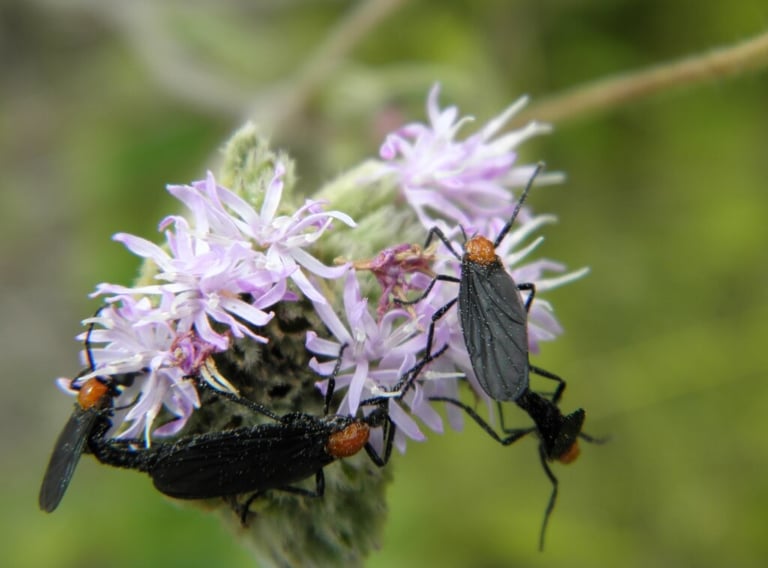

Another important aspect that draws love bugs is the availability of food sources. Adult love bugs primarily feed on nectar from flowering plants, and their presence can indicate a rich abundance of blooming flowers in the area. This is why they are commonly seen swarming around gardens, fields, and near highways where flowering plants are plentiful.
In addition to environmental conditions and food sources, love bugs are heavily influenced by their mating behaviors. As their name suggests, love bugs are notorious for their amorous encounters, especially during their mating season. The attraction to potential mates brings them together in large numbers.
Peak Periods of Activity
Love bugs in Florida are known for their seasonal abundance, typically appearing twice a year. The first peak period typically occurs in late spring, lasting from mid-April to mid-May. During this time, love bugs are highly active, making their presence more noticeable. The second peak period occurs in late summer, typically from late August to early September, and can last for several weeks.
How to Get Rid of Love Bugs
Love bugs can be a nuisance during their peak activity periods, but there are effective strategies you can use to manage their presence. By implementing physical barriers, utilizing insecticides, and taking preventive measures, you can minimize the impact of love bugs on your surroundings.
Physical Barriers: One of the most straightforward ways to reduce love bug encounters is by creating physical barriers. This can involve sealing cracks and gaps in windows and doors to prevent their entry into your home. Additionally, installing screens on windows and doors can act as a barrier, allowing fresh air in while keeping love bugs out.
When it comes to your vehicle, consider using a car cover or screen over the grill and radiator to prevent love bugs from getting caught or entering the engine. Regularly cleaning these barriers will ensure their effectiveness over time.
Preventive Measures: Preventing love bug encounters can start with simple measures. Keep your outdoor lights off at night, as they can attract love bugs. If you need to have outdoor lighting, consider using yellow or amber bulbs, as they are less attractive to love bugs than regular white bulbs.
Regularly clean your outdoor spaces, removing debris and decaying organic matter that can attract love bugs. Trim back vegetation and keep your lawn well-maintained, as love bugs tend to favor overgrown areas.
Additionally, consider using a fan or creating airflow in outdoor spaces. Love bugs are weak fliers, and a strong breeze can help deter them from settling in your surroundings.
To further prevent love bugs from sticking to your vehicle, apply a protective wax or coating. This will make it easier to remove their remains and reduce the chances of damage to the paint.
By employing these strategies and staying vigilant, you can effectively manage the presence of love bugs and reduce their impact on your daily life.
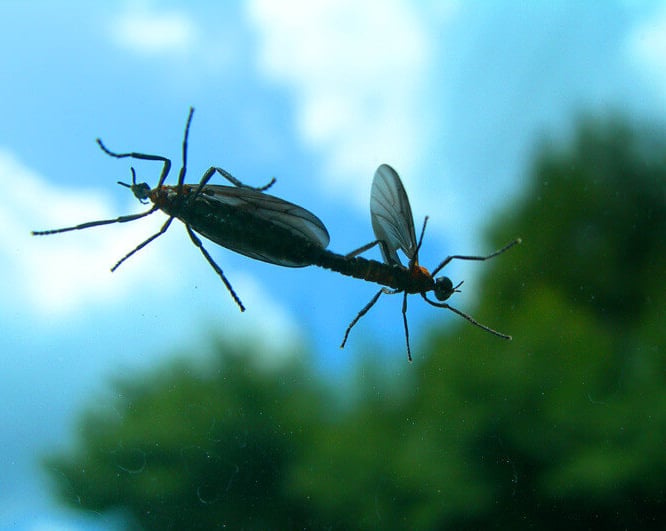

Love Bugs Bites: Fact or Myth?
Many people have heard the rumors... love bugs, those annoying little insects that swarm in Florida during certain seasons, have a notorious reputation for biting humans. But is this fact or just a myth? Let's set the record straight.
Contrary to popular belief, love bugs do not bite humans. These small, black insects with red thoraxes are actually harmless to humans and other animals. They may be annoying due to their abundance and tendency to fly in large swarms, but rest assured, they won't leave any bites or itchy welts on your skin.
Their harmless nature can be explained by the love bugs' diet and feeding habits. Love bugs primarily feed on nectar and pollen from flowers, making them more interested in plants than human flesh. They lack the mouthparts required to bite or sting, further confirming that love bugs are not a threat to humans.
So, why does the misconception about love bugs biting humans persist? One theory is that maybe it's their swarming behavior, especially around vehicles, may create some kind of perception that they are aggressive or causing harm. However, love bugs are simply attracted to the warm surfaces of cars and can become a nuisance due to their abundance.
So... love bugs may be a nuisance during specific seasons, but they pose no threat to humans. So the next time you encounter these insects, remember that they are harmless and avoid falling for the myth of love bugs biting. Instead, focus on finding effective ways to manage their presence and minimize any inconvenience they may cause.
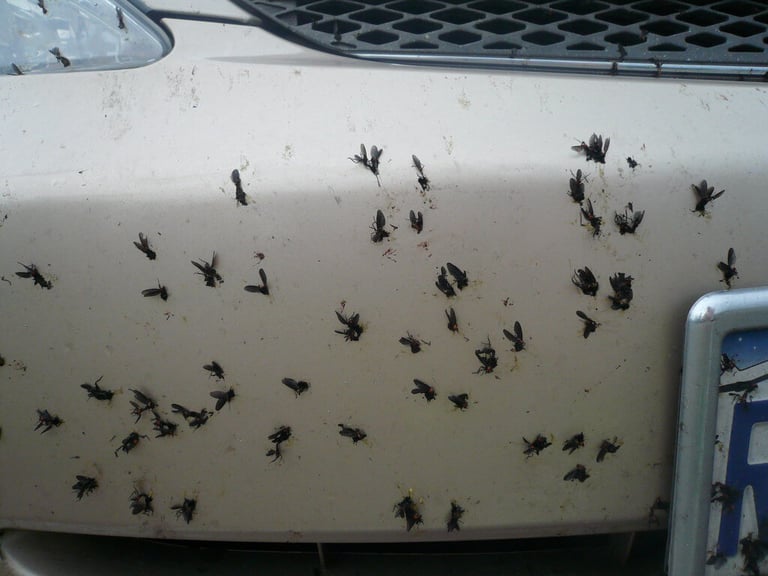

Removing Love Bugs from Your Car
Love bugs can be a nuisance, particularly when they cover your car's exterior. However, with the right cleaning methods and protective measures, you can effectively remove them and restore the pristine appearance of your vehicle.
Cleaning Methods
When tackling love bug residue on your car, it's important to use gentle yet effective cleaning methods to prevent any damage to the paintwork. Here are some recommended approaches:
Preparation: Before you start cleaning, gather the necessary materials such as a bucket, a microfiber cloth or sponge, and a gentle car wash soap. Avoid using harsh chemicals or abrasive tools as they can potentially harm the paint.
Pre-soak: Begin by pre-soaking the affected areas with water. This will help loosen the bug residue and make it easier to remove.
Gentle scrubbing: Using a microfiber cloth or sponge, gently scrub the love bug remains in a circular motion. Apply moderate pressure to avoid scratching the paint. For stubborn spots, you can use a bug and tar remover, following the manufacturer's instructions.
Rinse thoroughly: After scrubbing, thoroughly rinse your car with clean water to remove any remaining residue.
Drying: Finish the cleaning process by drying your car with a soft microfiber cloth or chamois to prevent water spots.
Protective Measures
Once your car is clean, it's important to take preventative measures to minimize future love bug encounters:
Waxing: Applying a high-quality automotive wax can create a protective barrier on your car's surface, making it easier to remove love bug residue in the future.
Car covers: Consider using a car cover when parking for extended periods, especially during peak love bug seasons. This will protect your car's exterior from direct exposure and minimize the need for frequent cleaning.
Regular cleaning: Establish a regular cleaning routine to promptly remove love bugs from your car. Regularly washing your vehicle can prevent the acidic bug residue from causing any damage to the paintwork.
By following these best practices for removing love bugs from your car and implementing protective measures, you can keep your vehicle looking its best and protect it from the seasonal influx of these pesky insects.
Tips to Minimize Love Bug Encounters
Love bugs can become a nuisance when their population increases during certain seasons. However, there are several practical tips you can follow to minimize love bug encounters and make your surroundings more comfortable. Whether you're indoors or outdoors, these strategies can help mitigate their presence:
1. Seal Entry Points
Love bugs can find their way into your home through small gaps and cracks in doors, windows, and walls. Seal any potential entry points, including gaps around pipes and electrical outlets, to prevent them from entering your living spaces.
2. Install Window Screens
Adding window screens to your doors and windows can serve as an additional barrier against love bugs. These screens allow fresh air to flow in while keeping insects, including love bugs, outside.
3. Keep Outdoor Lights Off
Love bugs are attracted to light sources, especially during their mating season. Minimize their attraction by keeping outdoor lights off or switching to yellow bulbs, which are less appealing to these insects.
4. Use Fans Outdoors
When spending time outdoors, set up fans in the areas where you'll be sitting or relaxing. The breeze from the fans can help deter love bugs from flying near you.
5. Clean up Debris
Love bugs are often found around areas with accumulation of organic matter and debris. Regularly clean up fallen leaves, grass clippings, and other yard waste to reduce their presence around your property.
6. Avoid Attracting Insects
Love bugs are attracted to decaying organic matter and moisture, which can include wet pet food, overflowing garbage cans, and standing water. Keep these attractants to a minimum and maintain cleanliness in and around your home.
7. Remove Love Bugs Promptly
If you spot love bugs indoors, remove them promptly using a vacuum cleaner or a broom. Remember to dispose of them in a sealed bag to prevent their escape.
By following these tips, you can minimize love bug encounters and create a more pleasant environment for yourself and your loved ones.
Conclusion:
Understanding love bugs and their seasonal impact is crucial for residents in areas where these insects thrive. By learning about their history, life cycle, and behavior, we can better understand how to manage their presence effectively.
It's important to note that love bugs are attracted to environmental conditions and available food sources. By eliminating factors that attract them, such as bright lights and decaying organic matter, we can minimize their presence.
Additionally, implementing preventive measures like physical barriers and insecticides can help reduce the number of love bugs in our surroundings. Regular cleaning and protective measures for vehicles can also prevent their accumulation on car surfaces.
Overall, by gaining knowledge about love bugs and adopting effective strategies, we can mitigate their impact and create more comfortable living environments for ourselves and our communities.
Love Bug FAQ:
How did love bugs end up in Florida?
Love bugs made their way to Florida from Central America in the 1940s. They first appeared in Texas. Then, they spread to other states, including Florida.
What factors attract love bugs?
Love bugs like sun, warmth, and rotting organic stuff. They also swarm around cars due to the heat and movement cars make.
When can I expect love bugs in Florida?
In Florida, you'll see love bugs the most during spring and fall. This is from April to May and September to October. They are very active at these times.
Do love bugs bite?
Love bugs are harmless and do not bite. They might be a nuisance but they do not harm people or pets.
How can I remove love bugs from my car without causing damage?
To clean love bugs off cars, use a careful method. Try soaking a cloth in warm, soapy water. Then, gently wipe the bugs away. For tougher spots, use a bug remover or vinegar.
Do love bugs have any ecological impact?
Love bugs help recycle by breaking down waste like dead plants and animal waste. They are also a food source for birds and small animals.
Are there natural methods to repel love bugs?
Yes, you can repel love bugs naturally. Plant herbs such as basil or mint around your home. You can also use essential oils like lavender in sprays to keep them away.
How can I effectively control love bug populations?
Since love bugs don't live long and aren't a big threat, you don't always need to control them. But, you can reduce their numbers by keeping your outdoor spaces clean. This includes using screens and getting rid of organic waste.
